After our visit to Devil’s Fork State Park, Alan Cressler and I drove about 30 minutes west to one of my favorite places for spring wildflowers: Oconee Station State Historic Site. This site was orignially established in the late 1700s as a blockhouse for soldiers on the frontier. It also served as a trading post for local residents and Native Americans.
The attraction for me, however, is the trail leading to a spectacular, 60-foot (20 meter) waterfall. All along this trail, in season, dozens of species of wildflowers bloom. This trail follows along the valley which contains a basic cove forest. Since most of the upstate of South Carolina is made up of acidic soils, there are many species in this cove that are not frequently found in other botanical sites in the area.
This is the premier site for Trilliums in the upstate. Both Trillium simile, Gleeson’s Trillium or Sweet white Trillium and Trillium Catesbaei, Catesby’s Trillium are found in this location, but both of them bloom a bit later in the season.
As one walks along the approximately 1-mile (1.6 km) trail, the visual senses are assaulted by tens of thousands of Trillium cuneatum , also known as Little Sweet Betsy, blooming on the forest floor:
A week or so after the Trilliums begin to bloom, one will find masses of Podophyllum peltatum or Mayapple covering the forest floor. If you look closely at the image below, you will find Trillium cuneatum still blooming, but a bit underneath the Mayapple leaves:
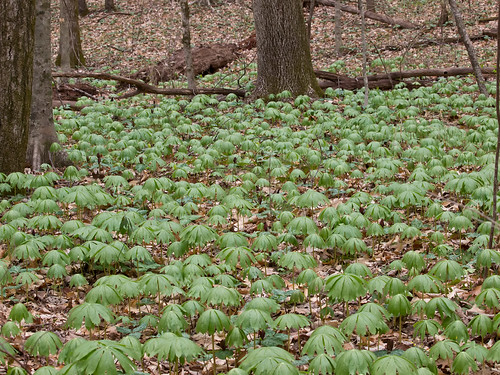
Trilliums grow from a rhizome, which forms a couple of inches below the soil. More than one flowering stem my sprout from a rhizome, so sometimes a cluster of several blooming stems may be seen. The color of the flowers from a particular rhizome will be identical.
This blog post will highlight some of the many color forms of Trillium cuneatum at Oconee Station. Here are two of the color forms growing next to each other:
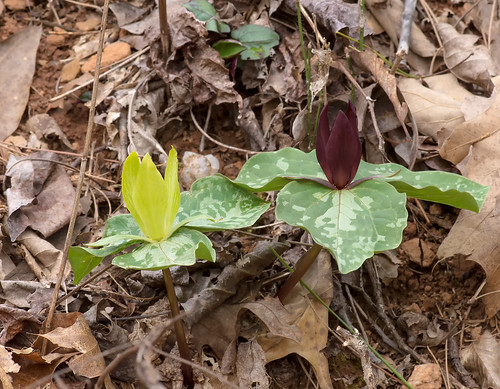
At this site, Trillium cuneatum exhibits three main color forms: Deep red, bronze, and yellow. Although some think that the yellow form is Trillium luteum, it is simply just a color form of Trillium cuneatum.
The first and by far the most common color form is the deep red form:
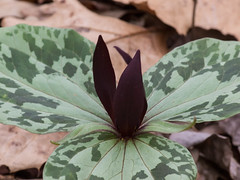 |
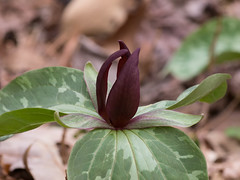 |
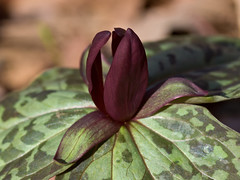 |
 |
The bronze color forms seem to be an intermediate between the deep red and yellow forms. This is not a pure color, but apparently a mixture of the red and yellow forms. Sometimes there will be streaks or patches of color in the bronze forms:
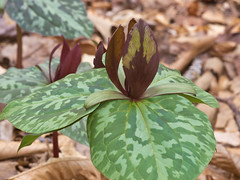 |
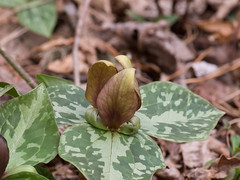 |
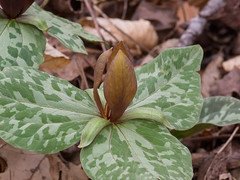 |
 |
Lastly, about one out of every five hundred or so plants will have flowers of the yellow color form. Occasionaly, the color of these yellow flowers approaches a dull green color:
 |
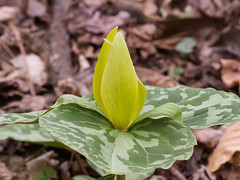 |
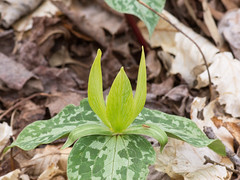 |
 |
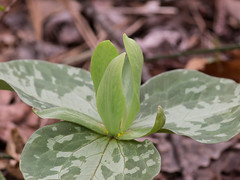
Finally, here is an image of Oconee Station Falls, which greeted us at the end of the trail:
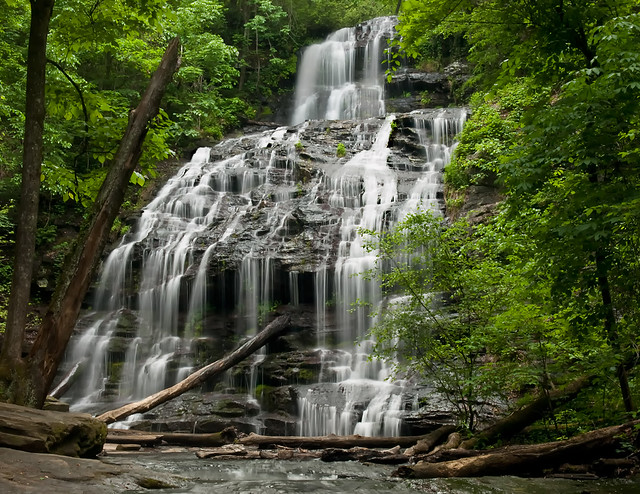
What a great day it turned out to be for photographing wildflowers! The sky was overcast, providing perfect, diffused light. The temperature was in the upper 60s, and the flowers behaved and bloomed when they were expected to bloom. What more could we have asked for?…
— Jim

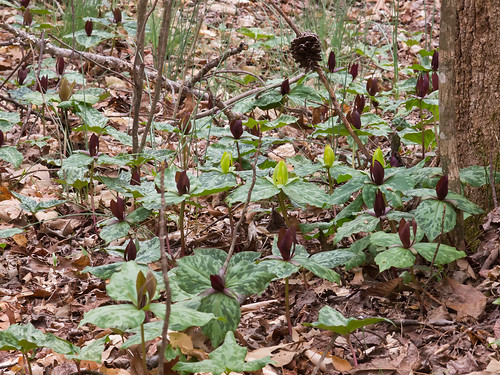
0 Responses
Excellent photos as usual; nice array of petal color variants. Hope none of the yellow ones were lemony; would be curious if they had same spicy odor as the burgundy ones?? Falls photo inspiring!!
Thanks for the good words, Tom! I’m always amazed at the huge color range on these flowers. Although Alan and I both sniffed a few of these flowers, I didn’t notice anything but the usual, musky, slightly spicy fragrance…
That’s a beautiful botanical site, and the trillium color forms are very interesting. We’re still under snow and ice here in Minnesota, but I hope to be able to see snow trilliums (T. nivale) in bloom within about three weeks or so.
The mayapple colony is impressive. That species reaches into southeastern Minnesota, but I have yet to see it in the wild here (there’s a nice planting, though, in the Minnesota Landscape Arboretum’s wildflower garden).
Another well written blog with some excellent photography Jim!
My only regret is not living closer to you guys, looks and sounds like a great place.
Love the falls image as well!
I just googled directions to this great site. History, wildflowers and a waterfall? What more is there? Sadly, 309 miles one way, but I’m still tempted. Expecting snow off and on for the rest of the week here, but I did just see Trout Lilly buds just above the leaf litter here. And, I am driving 175 miles one way this Saturday to see Snow Trillium, a first for me. Then 165 miles to a school event, then 120 miles home late that night. Almost 500 miles to see a two inch tall flower? Yes, worth every lonely mile. Great blog entry Jim.
Just 500 miles? 😉 Lol! Been there done that. I’ve even done that for a flower that failed to bloom that year. Oconee Station will be in the same place next year. When you decide to drive down, let me know, and I’ll meet you and show you the best nooks and crannies.
I’m confused! Did you take the waterfall photo and the mayapple photo during this trip? We have no signs of foliage here. Our patch of trilliums is growing though! Our mayapples just peaked their nubs out of the ground last week. I don’t think they’ve moved since — too scared of the cold!
Jen, in telling the story, I wanted to show a visual for the mayapples and the falls. The most representative shots I have were taken on past visits. However, some of the mayapples were up although most of them were just beginning to peek out of the forest floor…
When is the best time to see the trilliums , I know it can vary . Are there any pitcher plants ?
These particular Trillium plants are in bloom in our area around mid-March. The bloom time varies among the different Trillium species, but most of them bloom in the early Spring.